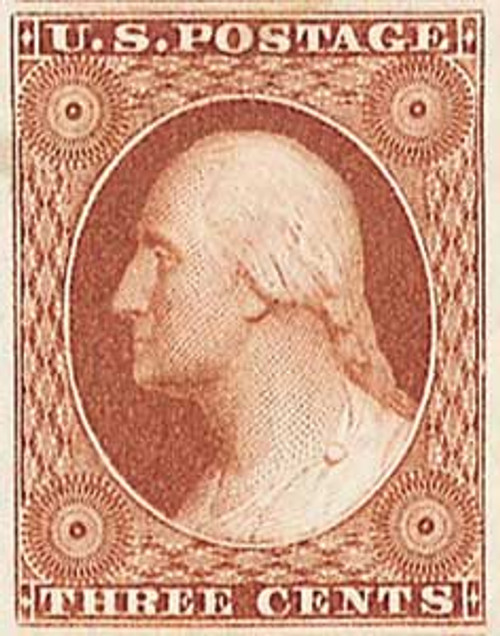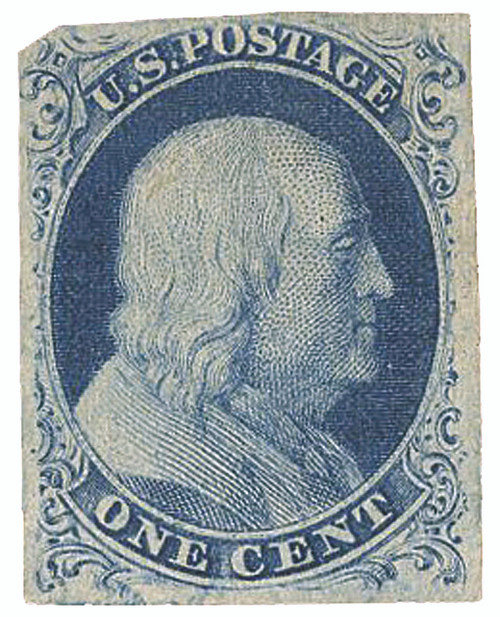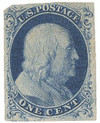
1851 1c Franklin, blue, type IIIa
# 8A - 1851 1c Franklin, blue, type IIIa
$825.00 - $5,000.00
U.S. #8A
1851 Franklin, Type IIIa
- First One-Cent U.S. postage stamp
Stamp Category: Definitive
Series: 1851-57 Issue
Value: 1c
Issue date: July 1st, 1851
Printed by: Toppan, Carpenter, Casilear & Co.
Format: Sheets of 200 stamps divided into two panes of 100 each
Printing Method: Engraving
Perforations: Imperforate
Color: Blue
Why the stamp was issued: The 1c Franklin was issued to pay the first-class rate for newspapers, drop letters, and unsealed circulars.
About the stamp design: The design is engraved on a die – a small, flat piece of steel. The design is copied to a transfer roll – a blank roll of steel. Several impressions or “reliefs” are made on the roll. The reliefs are transferred to the plate – a large, flat piece of steel from which the stamps are printed. A damaged plate or foreign matter can cause differences.
Types or “varieties” occur when a stamp has differences which vary from the way it was originally intended to be printed. These differences can occur when the design is being transferred to the plate for printing or when lines are manually re-cut.
Eight varieties of this stamp were created due to all the fancy scrollwork that had to fit. Recutting of the plates was done so the required number of stamps would fit. With the recutting came various levels of completeness of various design elements: frame lines, scrolls, scroll balls, plumes, and ornaments.
Lines re-cut on a worn plate can also result in double lines, called “double transfers”, as seen on the 1c Franklin Type I.
Special design details: US #8A is Type IIIa. Unlike Type III, where both the top and bottom outermost lines are broken at the center, on Type IIIa either top or bottom is broken. Side ornaments are mostly complete. Ben Franklin’s image on the stamp is based on a sculpture of him by French artist Jean Jacques Cafferi.
About the 1851-57 Series: On July 1, 1851, 1c, 3c, and 12c stamps were issued. These new stamps met the reduced postal rates passed by act of Congress on March 3, 1851. U.S. #1 and #2 were demonetized. Later reductions due to the Act of March 3, 1855 led to 10c (1855) and 5c (1856) additions to the series. Perforated stamps of the same design (plus three new designs) would be issued in 1857.
History the stamp represents:
America’s first two postage stamps were issued four years earlier in 1847. At the time, rates were determined by the weight and distance the letter was mailed. Letters mailed 300 miles or less were 5¢ per half ounce; while those mailed over 300 miles were 10¢ per half ounce. Postage could be paid by the sender at the time the letter was mailed, or by the addressee upon receipt.
The 5c rate served several purposes: the registration of valuable letters, and the shore-to-ship rate for some foreign countries. Two 5c stamps were sometimes used to pay the postage for letters traveling over 3,000 miles after 1855. And as of 1857, three 5c stamps paid the rate to France.
These stamps and rates remained in use until 1851. Then on March 3, 1851, Congress reduced postal rates. These new rates created a need for new denominations. The 1¢ stamp was used on all mail up to 3 ounces and on “drop letters” which were mailed to the same town. The single letter rate, based on a half-ounce, was changed to 3¢ for mail not over 3,000 miles. Mail exceeding this distance was lowered to 6¢. Letters sent to or from a foreign country over 2,500 miles cost 20¢ and foreign mail under 2,500 miles cost 10¢.
The first stamps issued to meet these new rates were issued on July 1, 1851. Prepayment was still optional. If postage was paid by the addressee upon receipt, the rate was higher. Due to increased collect rates, the use of postage stamps was greatly stimulated. The cheaper rates were attractive to Americans, too. Prepayment of postage with stamps was made mandatory January 1st, 1856.
U.S. #8A
1851 Franklin, Type IIIa
- First One-Cent U.S. postage stamp
Stamp Category: Definitive
Series: 1851-57 Issue
Value: 1c
Issue date: July 1st, 1851
Printed by: Toppan, Carpenter, Casilear & Co.
Format: Sheets of 200 stamps divided into two panes of 100 each
Printing Method: Engraving
Perforations: Imperforate
Color: Blue
Why the stamp was issued: The 1c Franklin was issued to pay the first-class rate for newspapers, drop letters, and unsealed circulars.
About the stamp design: The design is engraved on a die – a small, flat piece of steel. The design is copied to a transfer roll – a blank roll of steel. Several impressions or “reliefs” are made on the roll. The reliefs are transferred to the plate – a large, flat piece of steel from which the stamps are printed. A damaged plate or foreign matter can cause differences.
Types or “varieties” occur when a stamp has differences which vary from the way it was originally intended to be printed. These differences can occur when the design is being transferred to the plate for printing or when lines are manually re-cut.
Eight varieties of this stamp were created due to all the fancy scrollwork that had to fit. Recutting of the plates was done so the required number of stamps would fit. With the recutting came various levels of completeness of various design elements: frame lines, scrolls, scroll balls, plumes, and ornaments.
Lines re-cut on a worn plate can also result in double lines, called “double transfers”, as seen on the 1c Franklin Type I.
Special design details: US #8A is Type IIIa. Unlike Type III, where both the top and bottom outermost lines are broken at the center, on Type IIIa either top or bottom is broken. Side ornaments are mostly complete. Ben Franklin’s image on the stamp is based on a sculpture of him by French artist Jean Jacques Cafferi.
About the 1851-57 Series: On July 1, 1851, 1c, 3c, and 12c stamps were issued. These new stamps met the reduced postal rates passed by act of Congress on March 3, 1851. U.S. #1 and #2 were demonetized. Later reductions due to the Act of March 3, 1855 led to 10c (1855) and 5c (1856) additions to the series. Perforated stamps of the same design (plus three new designs) would be issued in 1857.
History the stamp represents:
America’s first two postage stamps were issued four years earlier in 1847. At the time, rates were determined by the weight and distance the letter was mailed. Letters mailed 300 miles or less were 5¢ per half ounce; while those mailed over 300 miles were 10¢ per half ounce. Postage could be paid by the sender at the time the letter was mailed, or by the addressee upon receipt.
The 5c rate served several purposes: the registration of valuable letters, and the shore-to-ship rate for some foreign countries. Two 5c stamps were sometimes used to pay the postage for letters traveling over 3,000 miles after 1855. And as of 1857, three 5c stamps paid the rate to France.
These stamps and rates remained in use until 1851. Then on March 3, 1851, Congress reduced postal rates. These new rates created a need for new denominations. The 1¢ stamp was used on all mail up to 3 ounces and on “drop letters” which were mailed to the same town. The single letter rate, based on a half-ounce, was changed to 3¢ for mail not over 3,000 miles. Mail exceeding this distance was lowered to 6¢. Letters sent to or from a foreign country over 2,500 miles cost 20¢ and foreign mail under 2,500 miles cost 10¢.
The first stamps issued to meet these new rates were issued on July 1, 1851. Prepayment was still optional. If postage was paid by the addressee upon receipt, the rate was higher. Due to increased collect rates, the use of postage stamps was greatly stimulated. The cheaper rates were attractive to Americans, too. Prepayment of postage with stamps was made mandatory January 1st, 1856.
















